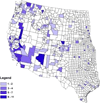Tick-borne relapsing fever
- PMID: 18755384
- PMCID: PMC3725823
- DOI: 10.1016/j.idc.2008.03.006
Tick-borne relapsing fever
Abstract
Each year, many residents of and visitors to endemic regions of the western United States are exposed to the tick vectors of tick-borne relapsing fever (TBRF), Ornithodoros hermsi, Ornithodoros turicata, or Ornithodoros parkeri. This disease is remarkable because the human host is unaware of the tick bite, usually becomes very ill, may experience an exacerbation of symptoms rather than improvement shortly after beginning appropriate treatment, and, despite often high numbers of the etiologic organism in the blood, rarely dies as a result of the illness. Although relapsing fever is acquired in many parts of the world, this article focuses primarily on knowledge about TBRF in North America.
Figures



References
-
- Goubau PF. Relapsing fevers. A review. Ann Soc Belg Med Trop. 1984;64:335–364. - PubMed
-
- Dennis DT, Hayes EB. Relapsing fever. In: Braunwald E, Hauser SL, Fauci AS, editors. Harrison’s principles of internal medicine. 16th edition. New York: McGraw-Hill; 2005. pp. 991–995.
-
- Southern PM, Sanford JP. Relapsing fever: a clinical and microbiological review. Medicine. 1969;48:129–149.
-
- Washington State Department of Health. Morbidity and mortality summary. Seattle (Washington): Washington State Department of Health; 1993. Relapsing fever; pp. 77–78.
-
- Moursund WH. Historical introduction to the symposium on relapsing fever. In: Moulton FR, editor. A symposium on relapsing fever in the Americas. Washington, DC: American Association for the Advancement of Science; 1942. pp. 1–6.
Publication types
MeSH terms
Substances
Grants and funding
LinkOut - more resources
Full Text Sources
Other Literature Sources
Medical

